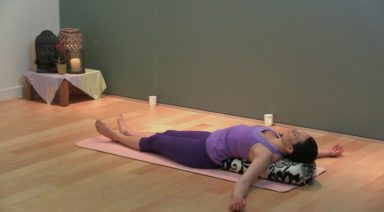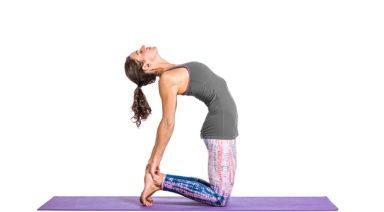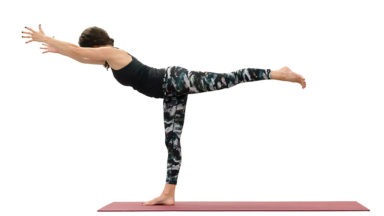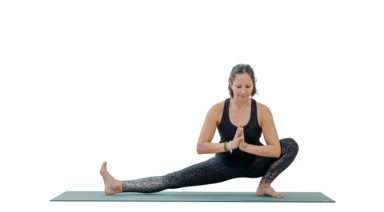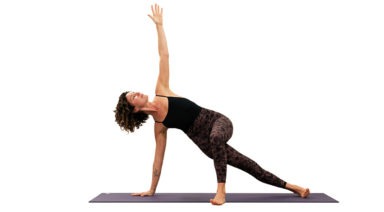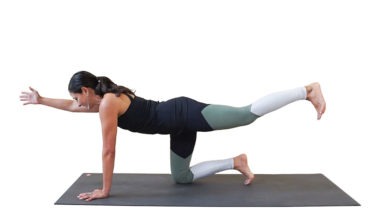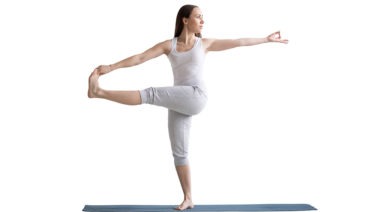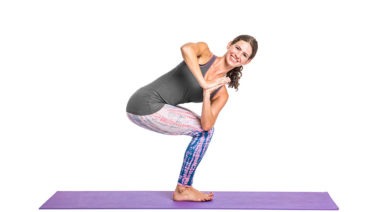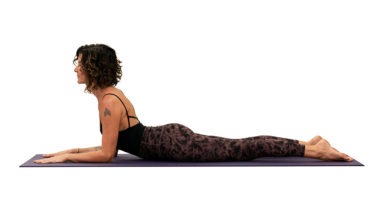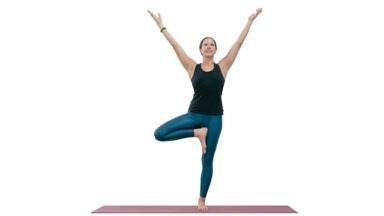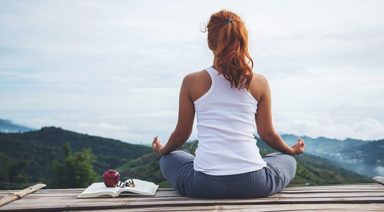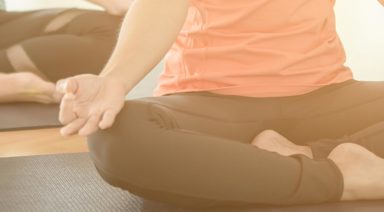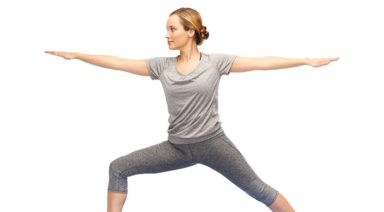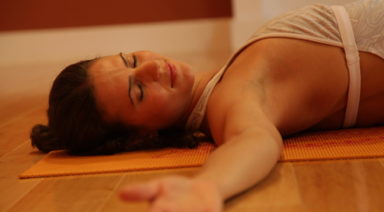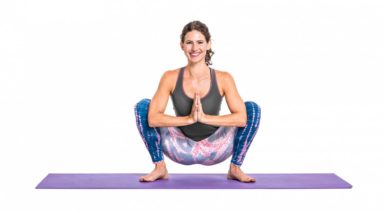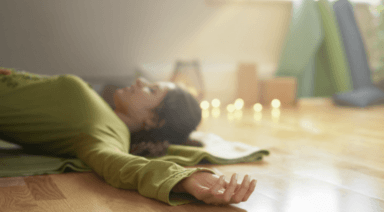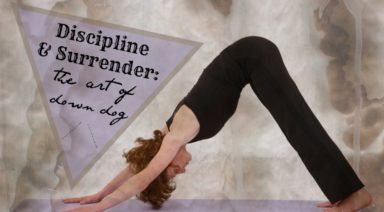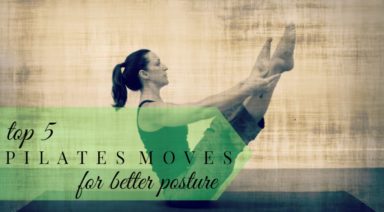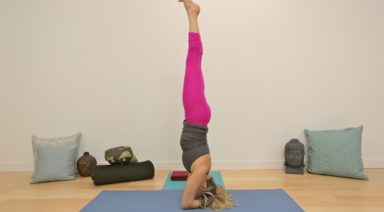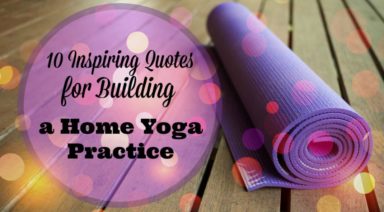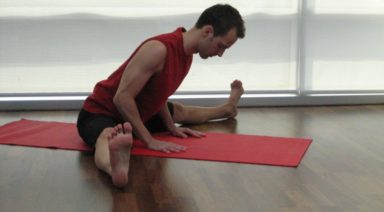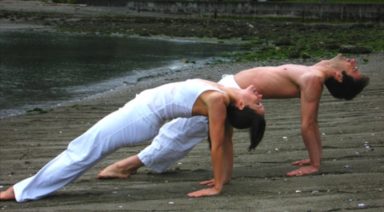Yoga, Crohn’s Disease and How I Got My Life Back

When people ask me how I got into yoga, I usually tell them I used it to rehab an injury. That’s true. After fracturing my lower back, yoga helped me regain strength and flexibility in my back and left leg, both of which were also affected by the fracture. I tell them how at peace yoga makes my mind and body feel. I explain how yoga makes me feel better in all aspects of my life. I tell them I believe yoga is great for the body but better for the soul, and when I teach, I rattle all off the bountiful mental, physical, emotional, and health benefits of each pose.
Sometimes I wonder whether people taking the class and therefore listening to the long list of benefits, wonder if I did an extensive Google search before hitting the mat. I wonder if they ponder whether I cite yoga’s healing powers because it sounds good or because a guru told me about them.
Living with Crohn’s Disease
What most people don’t know is that I’ve experienced yoga’s healing firsthand, and not just with an injury. What I never tell people―whether it be out of embarrassment or because it never comes up in conversation―is that I have a chronic illness. I have Crohn’s disease. To put it simply, Crohn’s is the inflammation of the gastrointestinal tract, which is every bit as glamorous as it sounds. Basically, my immune system attacks my gastrointestinal tract. Unfortunately, there isn’t a tremendous amount known about Crohn’s: Although it is an immune-related disease, it isn’t technically an autoimmune disorder. There is no known cure for Crohn’s.
I have always had a sensitive stomach, but around the age of fourteen or fifteen, my symptoms shifted. I determinedly ignored the fact that I was sick. Then, this past summer, debilitating pain resulted in me being hospitalized and receiving the official diagnosis.
Crohn’s isn’t fun to discuss and even less enjoyable to have. It isn’t a “trendy” illness or allergy (not that I believe any disorder or disease falls into that category); it is awkward and often unpredictable. It makes everyday activities, like going to work or going out, seem like monumental tasks. Aside from being almost perpetually sick to my stomach―I have learned to hide this well―Crohn’s comes with a whole host of sub-symptoms: I have episodes of exhaustion so intense that sometimes talking seems like work (challenging for someone like me, who loves good conversation), my joints ache, I’m usually unintentionally vitamin deficient. This has resulted in anemia, meaning my iron levels are low.
I’ve tried every elimination diet in the book. Half the time, I get so exhausted and frustrated trying to figure out what or when to eat, it feels easier to just not eat anything. So I usually don’t, which prompts all sorts of (warranted) questions about my dubious eating habits. The worst part is the nearly all-consuming anxiety that stems from never feeling in control. Over the summer, I was embarrassed to leave my dorm. I looked sick: Hair coming out in handfuls, pale, dry skin. It didn’t look pretty and felt even worse.
How Yoga Gave Me My Life Back
So how in the world does a person like this do yoga, let alone anything else? Honestly, I believe that yoga makes it possible.
As a former ballet dancer, I practiced yoga occasionally, using it as a training supplement, but two years ago, as a freshman in college, I really fell in love with it. Caught up in feeling lonely and sick and sorry for myself, I stumbled into a hot yoga class.
I haven’t been the same since.
I emerged feeling rejuvenated and alive in a way I hadn’t in a long time. I felt clear-headed and alert, but calm. I wasn’t anxious about my stomach or whatever was happening in my life at that moment. Yoga stripped away the layers of illness, insecurity, and panic, and built them back up with peace. Peace, I found, is the most fulfilling substance of all.
I don’t use prescription medication to treat Crohn’s. I take over-the-counter meds on an as-needed basis. I’ve tried to restore my body to as natural a state as possible, and while I believe yoga has certainly helped with the physical symptoms of the illness, what I think it really changed was my mind.
What You Think You Become
“What you think, you become” is not an overstatement. If you think frantic, depressing thoughts, they will eventually manifest themselves physically. When your entire body feels broken, it is all too easy to fall into a “what is wrong with me” mindset.
Yoga doesn’t try to answer the question “What is wrong with me?” Instead, yoga demonstrates all the many, many things that are right with you. It shows you yourself at your purest, your freest, your lightest. That version of you is the truth. We all have things that are less than ideal, whether it be a difficult situation, an illness, poor body image. But what we forget is that we all possess things that are inexplicably right; that are noble and wonderful and worthy. Yoga made it possible for me to see these things in myself.
I actually credit Crohn’s with a lot. Because of this illness, I am more patient and understanding, I am more in tune with my body and I try to focus on what is right instead of the wrong.
I have a long way to go and a lot to work on, but every time I stand on a yoga mat, I feel myself getting better. I want people to know that whatever you believe is wrong with you, there are dozens of things that are right with you, and the world deserves to see them. You owe it to yourself. Every time you feel too sick or too sad or too wrong, please step onto that mat, close your eyes and let yoga heal every part of you.
It is the greatest cure.
How Yoga Can Help Improve Your Skin

The skin on someone’s face is one of the first things we notice, so it’s only natural that we would desire healthy, beautiful skin. Sadly enough, our skin is also one of the first things to be affected by poor diet and stress. Beyond just covering up with makeup, or religiously applying face creams at night, there are other things that can be done to improve the look and feel of your skin.
Yoga is one of the most effective things we can do to help our skin to stay beautiful and glowing. There are a variety of different poses that will work to your advantage, each with different benefits, but first: what really causes your skin problems?
Skin problems and their causes
Acne is the bane of many individuals – it always seems to be a problem. Luckily, it tends to heal itself and, if treated properly, will not leave any lasting scars.
Oftentimes, a person’s health history has a lot to do with the way his or her skin looks now. If they spent a lot of time outdoors without proper sun protection, or smoked frequently, these things will probably affect their skin negatively.
A poor diet can also cause poor skin: leading to more breakouts and excess oil that clogs pores.
Yoga’s healthy skin benefits
What is yoga actually doing to help improve my skin? Yoga works to improve digestion and circulation. When your body has better blood flow, it naturally produces glowing skin.
Practice doing poses like wind-relieving posture and bow pose, and try alternating nose breathing. All of these practices will aid in digestion. Glowing skin comes with a digestion system that is working properly.
Other yoga poses, such as child’s pose, fish pose and shoulder stand, are also extremely effective in increasing blood circulation throughout your entire body – especially the face and brain – thus stimulating the skin.
Skin loses its elasticity easily, so it is also helpful to do facial exercise which will strengthen and tone the muscles in your face. Stretch your lips and massage your jaw and brows to relieve stress. This practice will also help you to gain elasticity in your face.
What else can I do to get beautiful skin?
Of course yoga is not the only way to improve the look of your skin! In addition to practicing yoga everyday as a regular part of your routine, there are several other habits you can implement into your life so that you can enjoy radiant skin:
1. Drink more water than you think you need. Water flushes out toxins and gives your skin a healthy, lustrous glow.
2. Aim for eight hours of sleep a night. Although this sometimes seems impossible, due to the busyness of life, by being sufficiently rested, you will also look awake and alert. Over time, this will affect the health of your skin in a positive way.
3. Consider getting facials at a spa as part of your regular routine. Facials work to rid your skin of impurities and help to produce a youthful, healthy glow.
By starting to incorporate yoga into your everyday life, you will begin to notice a big difference in the way your skin looks and feels. It will look younger, more vibrant and have a nice glow to it that others will surely notice. When done in unison with the other tips I’ve mentioned, you will be well along your way to having younger-looking skin in just a few weeks!




